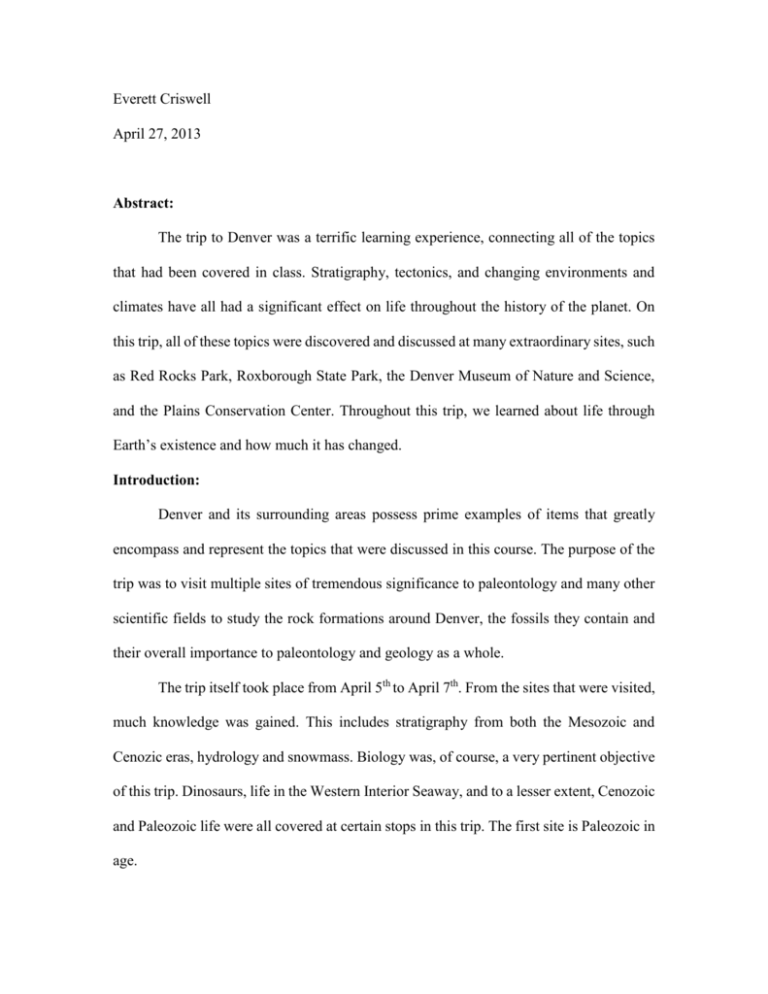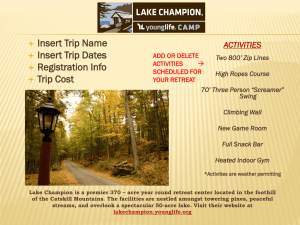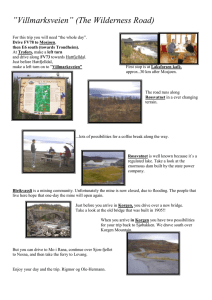Geo204Paper - Sites at Penn State
advertisement

Everett Criswell April 27, 2013 Abstract: The trip to Denver was a terrific learning experience, connecting all of the topics that had been covered in class. Stratigraphy, tectonics, and changing environments and climates have all had a significant effect on life throughout the history of the planet. On this trip, all of these topics were discovered and discussed at many extraordinary sites, such as Red Rocks Park, Roxborough State Park, the Denver Museum of Nature and Science, and the Plains Conservation Center. Throughout this trip, we learned about life through Earth’s existence and how much it has changed. Introduction: Denver and its surrounding areas possess prime examples of items that greatly encompass and represent the topics that were discussed in this course. The purpose of the trip was to visit multiple sites of tremendous significance to paleontology and many other scientific fields to study the rock formations around Denver, the fossils they contain and their overall importance to paleontology and geology as a whole. The trip itself took place from April 5th to April 7th. From the sites that were visited, much knowledge was gained. This includes stratigraphy from both the Mesozoic and Cenozic eras, hydrology and snowmass. Biology was, of course, a very pertinent objective of this trip. Dinosaurs, life in the Western Interior Seaway, and to a lesser extent, Cenozoic and Paleozoic life were all covered at certain stops in this trip. The first site is Paleozoic in age. Red Rocks Park and Amphitheatre: The very first stop in this trip is the Red Rocks overlook. The Fountain Formation is present here and one can see the Dakota Hogback in the distance, which contains the Lyons Formation, the Lykens Formation, the Morrison Formation, and the Dakota Formation. The Fountain Formation here is a coarse grained red sandstone with interbedded shale that is 300 million years old, making it Pennsylvanian. Fossils are very rare in this area of the formation, although fossilized root systems have been found, which are indicative of trees. Some marine invertebrates have also been found in this formation, including bryozoans, gastropods, and brachiopods. The environment of deposition is a stream bed that flowed from a mountainous region. The most appropriate reconstruction of this in Ancient Denvers is the Ancestral Rockies. Here, it is notable that the Fountain Formation has been bent upward with a dip of about 35°. This folding would have occurred during the rise of the Front Range of the Rocky Mountains. The second stop was at the Red Rocks Amphitheatre. The Fountain Formation comprises this area as well, but there is a Precambrian gneiss formation present here as well. The overlying Fountain Formation is 300 million years old, and the gneiss is 1.7 billion years old. This phenomenon is called the Great Unconformity. This gap of over a billion years is present in both Colorado and Wyoming. This unconformity was created by the uplift and erosion of the layers that are not present here. Dinosaur Ridge: Dinosaur ridge, or the Dakota Hogback, was the next stop. The first visible formation here was the Morrison Formation. It is fine grained sandstone that is late Jurassic in age and tan in color. Because of those features, it represents a lush, meadow environment. The reconstruction that is the most appropriate for this area is the long neck meadow. Dinosaur bones are very abundant in the Morrison Formation, including the remains of such beasts as Aptosaurus, Diplodocus, and Stegosaurus. Also present are large bulges in the strata, which are essentially the footprints of these large creatures. The next formation here is the Dakota Formation which is overlying the Morrison Formation. The Dakota Formation is a very fine grained white sandstone that is approximately 100 million years old, which means that it is mid-Cretaceous. The environment of deposition for this formation would be a tidal flat. At this part of Dinosaur Ridge, the first very apparent feature is very prominent ripple marks with a northeast direction of flow. Another interesting feature on the Dakota formation, located slightly down the ridge from the ripple marks are billions of small pock marks. This is bioturbation caused by small marine invertebrates. Further down the ridge from here, hundreds on dinosaur footprints are visible on the surface of this formation. These were created primarily by Eolambia, Acrocanthosaurs, and Ornithomimids. Overlying the Dakota Formation here is the Benton Formation, which is comprised of gray shale. This is indicative of a deep marine depositional environment. In this case, this formation represents the bottom of the Great Western Interior Seaway. Fish scales are very common here and shark teeth are found occasionally as well. In other Benton Formation sites much more diverse fossils have been found, such as clams, ammonites, and large marine reptiles. Because of these finds, the Benton Formation excellently represents the menagerie of the Great Western Interior Seaway. Green Mountain: The final stop of the first day of the trip was at Green Mountain. Near the bottom, the rock types present are andesite, granite, and quartz in even proportions. Near the middle, all three rock types are still apparent, but the amount of andesite has decreased substantially. Around the top of Green Mountain, quartz and granite are abundant, but andesite is virtually non-existent. This phenomenon is caused by the exfoliation of an andesite layer during uplift that occurred as a result of the Laramide Orogeny. The K-Pg boundary is present at Green Mountain, but it is incredibly difficult to detect. Roxborough State Park: The second day of the trip started at Roxborough State Park. Here, Precambrian gneiss, the Fountain Formation, the Lyons Formation, The Lykins Formation, and the Dakota Formation are all visible. The Lyons Formation is 280 million years old and is composed of a very fine grained light tan sandstone. This formation is made up of aolian dune deposits, which means that the depositional environment for the Lyons Formation was a desert much like the Sahara today. In Ancient Denvers, the Sand Planet Reconstruction represents this formation. The Lykens Formation is 250 million years old and consists of beds of a pale tan limestone and red mudstone. The depositional environment for this formation would be a tropical shoreline that is home to many stromatolites, but not much else. The Denver Museum: The final stop of the second day was at The Denver Museum of Nature and Science. Tours of the bone room were led by Ian Miller who is a curator at the museum. In the bone room, there are many spectacular specimens of life from the past. Some of the best examples were the many mammoth and mastodon bones and tusks, the skeleton of a giant sloth, various dinosaur remains, a Tylosaur skeleton, mosasaur remains including full skulls, many ammonites, and myriad other items. One of the most notable parts of the room was their vast collection of leaves. These were organized by age and naturally, there is a dramatic drop in diversity at the K-Pg boundary. Some of the most superb specimens and samples are housed in the Prehistoric Journey exhibit of the museum. A large slab containing eight Carboniferous crinoids was one of the most significant items on display here. The preservation of the crinoids is excellent and there is clear evidence of gastropods consuming them. Another sample of interest was the enormous head plate of Dunkleosteus. This was an extremely large Devonian placoderm, growing to around 10m and weighing several tons. Although it had no teeth, it was a hypercarnivorous fish, possessing one of the most powerful bites of anything that has ever lived. Also of great intrigue in the exhibit were the skeletons of Dimetrodon and Eryops, both early Permian in age. Dimetrodon was a protomammal, which is indicated by its massive canines and well developed shearing teeth. It is also classified this way because of its synapsid skull structure. Eryops was a large carnivorous amphibian. They possessed two rows of sharp teeth which means that it ate other vertebrates. Many incredible dinosaurs were on display in the exhibit, such as Stygimoloch, Coelophysis, Tyrannosaurus Rex, Triceratops, and Diplodocus. One of the greatest displays in the Prehistoric Journey exhibit was the one of all the life in the Great Western Interior Seaway. The famous Xiphactinus fossil with a fish inside of it was incredibly impressive as were the large mososaurs and plesiosaurs. An enormous turtle with a shell diameter of approximately two meters hung from the ceiling. Many excellent ammonites were on display of all types. Ammonites are excellent for stratigraphy because of their extraordinary diversity and their very quick rates of evolution. One ammonite here was of particular interest because it had bite marks from a mososaur. This is absolute evidence of predation between the two organisms. All of these extraordinary fauna show that it certainly was the grandest seaway of its time. Daniel’s Park: On the final day of the trip, the first stop was at Daniel’s Park. The rock type here is a sandy coarse grained conglomerate. Clasts of feldspar, quartz, and plagioclase are present in the rocks and are very angular in shape. Cross bedding is very visible in this formation. These features indicate a high energy fluvial environment. This formation is called the Dawson Arkose and in Ancient Denvers is represented by the Red Dirt World reconstruction. Castle Rock: The second stop was at Castle Rock and there appear to be two different facies present here. At the bottom, there is a white sandy conglomerate that is coarse grained and moderately well sorted. Above this there is a very poorly sorted dark tan conglomerate that is coarse grained. Both contain clasts of quartz, plagioclase, k-feldspar, and rhyolite. These two facies are indicative of a high energy fluvial environment and that Castle Rock was once the bottom of a canyon. It is now the top of a butte due to inverted topography. Plains Conservation Center: Finally, the last stop of the trip was at the Bijou Creek Formation at the Plains Conservation Center. This site is significant because it has the most prominent exposure of the K-Pg boundary in the world. There are many clay layers here, and one in particular, which is darker than the others, represents the K-Pg boundary. Dinosaur teeth have been found eleven meters below the boundary and early Paleocene mammals have been found fourteen meters above it, signifying the mass extinction. Great evidence for the extinction has been found at this site, including the famous iridium layer, dinosaur remains, shocked quartz, and an incredible abundance of fossilized plants. Conclusion: Overall, the trip to Denver was a fantastic experience from a scientific standpoint. Geology played an incredibly significant role in determining the kind life that would be in Denver and its surrounding areas at any given time. The Sevier Orogeny created the Great Western Interior Seaway, where marine plants and animals of all kinds thrived. On the shores of the seaway, dinosaurs were very prevalent because the climate around Denver in the Cretaceous period had become very warm. Eventually, when the Great Western Interior Seaway closed during the Laramide Orogeny, the area became a rainforest, which continued to a smaller extent after the bolide impact at the K-Pg boundary. Gradually, the climate of Denver cooled to its current state and life changed with the climate. Obviously, life over all of time has been affected by changes in environment, tectonics, and climate. All of these variables have an effect on each other and this sort of interplay determines what will live in a location, such as Denver, over any given time. The trip to Denver was an incredible educational experience that really connected everything that has been covered in the course. Each stop was very fascinating and certainly put Prehistoric Journey and Ancient Denvers into perspective. Visting the site of the Castle Rock Rainforest might be very interesting and beneficial if time allows on the trip next year. Certainly, a lot was learned during this trip to Denver and not just paleontology, but geoscience, biology, and numerous other fields. References Cobban, William A. A USGS Table for the Upper Cretaceous Middle CenomanianMaastrichtian of the Western Interior of the United States Based on Ammonites, Inoceramids, and Radiometric Ages. 2006. U.S. Geological Survey. Everhart, Michael J. Oceans of Kansas. Indiana University Press. 2005. Johnson, Kirk R. Ancient Denvers. 2006. Denver Museum of Nature and Science. Johnson, Kirk R. Prehistoric Journey. 2006. Denver Museum of Nature and Science. Nicholls, Elizabeth L. Paleobiogeography of the Cretaceous Western Interior Seaway of North America: the vertebrate evidence. University of Calgary. 1990.






